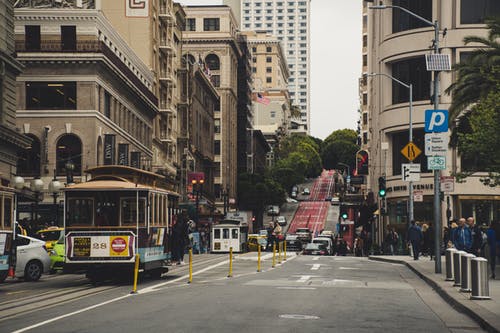
By Celia B., Marketing Manager
A few weeks ago, I had the opportunity to visit San Francisco as part of my attendance to one of the industry tradeshows being held there. As it was my first visit to the city, I took the opportunity to explore the sights and culture of the city, in addition to attending the tradeshow events. It was during one of these adventures that my understanding of final-mile delivery, and how difficult it can be, took on a whole new meaning.
I was amazed by the architecture, steep rolling hills, and unique atmosphere that permeated downtown San Francisco. As I come from a small rural town, I am always astounded by the amount of traffic found in large cities. In the case of San Francisco, I was particularly intrigued by the plethora of delivery trucks that were on every block and road in the city, no matter what part of the city I found myself in.
Drivers spend long days delivering freight to the final destination, often working 12-hour days to ensure deliveries are on time. Much of that time is spent sitting in traffic, especially in a city like San Francisco, where the traffic is intense and traffic lights are both a curse and a blessing. To unload, drivers find that they must park in the right lane, as there is no room anywhere else, despite the obvious difficulties that causes for the city.
There are a lot of challenges involved with final-mile delivery. Including a little-thought-about challenge brought up by Transport Topics in their article, “Solving the ‘Final 50 Feet’ Delivery Challenge.” The article explains, “The final 50 feet of urban delivery begins at a city-owned commercial vehicle loading zone or alley, or at the loading dock or zone at a privately-owned building. It ends where the owner takes delivery of goods. It incorporates the vertical elements of a building. It starts at the sidewalk and goes up a 70-story tower.”
With increased traffic and increased number of laws limiting where, how long, and when a driver can stop to make a delivery, it’s no wonder drivers have had to get creative in their delivery methods.
Which brings me back to San Francisco. While sitting in the back seat of my Uber ride, waiting for yet another red light, I saw a method of final-mile delivery out the window that I’d never imagined. I hurried to pull out my phone and ended up with this video gem:
Needless to say, a pair of electric pallet jacks zooming down the street (sadly, I was only able to capture one on video) was the last thing I expected to see that day!
It turns out that the truck was parked in front of a store about a block away. They made their deliveries to the store and, rather than having to navigate the truck down another busy city street, they had decided it was more efficient to drive the pallet jacks down another block or so, using the jack/load as their seat. Genius. But hard on pallet jack batteries.
Circumstances like this make final-mile delivery (or, in this case, final 2 city blocks) easy for the driver, but hard on the equipment. This necessitates making sure equipment is well taken care of when not in use to ensure maximum return on investment. In the case of electric pallet jacks, maintaining the battery at a high state of charge is key to success.
An easy solution for keeping pallet jack batteries in tip-top shape is to allow the pallet jack batteries to charge while the driver is on the way to their next stop, using a product such as Purkeys’ Trailer Auxiliary Power System (TAPS)™. This way, while sitting in traffic, the jack can be plugged in and kept ready for those final city block deliveries.
For more information on our products or how we can improve your deliveries, contact our team today!
